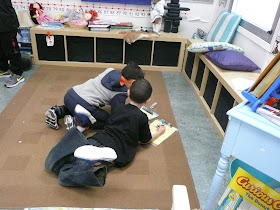This past week the students continued to work with adding and subtracting large numbers using some other strategies. In this one, which I call 'the pull down method', the students are again recognizing the value of the digits based on the place that they occupy in the number. The idea is to understand that when adding or subtracting, the tens work together and the ones work together. On the first day of introduction, the students struggled but,
on the next day, I had them work in pairs so that they could talk about their thinking, and help each other. There was much more success!
The students understand that they are practising these strategies but that in the long run, they will be able to use the one that they understand best....which one their brain likes :)
By the end of the week, the students were ready to work on this strategy which is often called the 'break apart' strategy. It should look familiar, because the students are taking the two digit number and writing it in expanded form and then again seeing that they will add or subtract the tens together and the ones together. After a couple days practise, the students will be ready to be introduced to the traditional algorithm that most students in North America are familiar with. Fingers crossed that they will not find it too complicated. In the end, they will still be allowed to choose which strategy works for them this year, as they need to understand the values of the numbers and the reason for working with tens and ones in the correct way.
It's hard to believe that this wonderful story is now 37 years old! We are using it to really recognize different aspects of reading.
This lesson went so well. The students used sticky notes to share what Elizabeth was like on the 'inside', her character traits and then created a poster about her. They each also made their own 'Elizabeth' paper doll. I think each has it's own unique style!






































